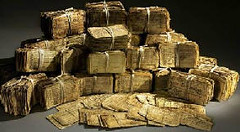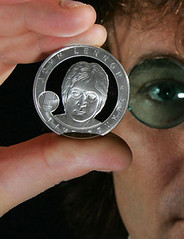
About UsThe Numismatic Bibliomania Society is a non-profit organization promoting numismatic literature. For more information please see our web site at coinbooks.org SubscriptionsThose wishing to become new E-Sylum subscribers (or wishing to Unsubscribe) can go to the following web page link MembershipThere is a membership application available on the web site Membership Application To join, print the application and return it with your check to the address printed on the application. Membership is only $15 to addresses in the U.S., $20 for First Class mail, and $25 elsewhere. For those without web access, write to: David M. Sundman, Secretary/TreasurerNumismatic Bibliomania
Society AsylumFor Asylum mailing address changes and other membership questions, contact David at this email address: dsundman@LittletonCoin.com SubmissionsTo submit items for publication in The E-Sylum, just Reply to this message, or write to the Editor at this address: whomren@coinlibrary.com
BUY THE BOOK BEFORE THE COINYou won't regret it! |
- WAYNE'S WORDS: THE E-SYLUM NOVEMBER 14, 2010
- KOLBE & FANNING AUCTION CLOSES THURSDAY NOVEMBER 18TH
- BOOK REVIEW: 2011 U.S. COIN DIGEST
- COURT TRIAL LIKELY IN CASE OF SEIZED 1933 DOUBLE EAGLES
- A PRIMER ON PLATING FOR ALL COLLECTORS
- KILKENOMICS FESTIVAL CURRENCY: THE MARBLE
- MORE ON THE GERMANY REPARATIONS COMMISSION PHOTO
- MORE ON THE NORTH CAROLINA COLONIAL CURRENCY HOARD
- OFFICIAL REPLACEMENT VICTORIA CROSS MEDALS
- MORE ON COIN REPLICAS AND THE HOBBY PROTECTION ACT
- MORE ON THE LOUIS ELIASBERG COLLECTION
- NOTES FROM E-SYLUM READERS: NOVEMBER 14, 2010
- WAYNE'S NUMISMATIC DIARY: NOVEMBER 14, 2010
- SO WHAT'S A 'DEL BOY'?
- DECEMBER 2010 SPINK SALE OF ANCIENT, ENGLISH AND FOREIGN COINS
- IRELAND'S “BARNYARD” EURO COIN SERIES EXTENDS CLASSIC DESIGNS
- TRUE STORY: THE UPSIDE DOWN COIN INSCRIPTION
- FEATURED WEB SITE: MILITARY COIN COLLECTING
WAYNE'S WORDS: THE E-SYLUM NOVEMBER 14, 2010

Among our new subscribers this week is Lloyd Wagner. Welcome aboard! We now have 1,389 email subscribers, plus 92 followers on Facebook, including Donn Pearlman, Pierre Fricke and Donald Yarab.
First, a correction. Roger Burdette's special offer on his new Assay Commission book for readers of The E-Sylum offer is good through December 10 - see his ad in this week's issue.
OK, another correction. In last week's Wayne's Word's I mentioned "Louis Eliasberg's unique 1877-CC No Arrows Dime". Harold Levi spotted the typo - it should be 1873.
Many thanks to Leon Saryan and Wayne Schroll for assisting Oded Paz in his quest to contact Turkish numismatists.
AOL will be the death of me yet. We've always had proportionately more problems reported by AOL subscribers than any other ISP. Over the last several weeks we've been investigating a problem where a small subset of our AOL subscribers get an empty E-Sylum message or none at all.
The AOL headquarters is just up the road from my house and I pass it nearly every day. If I knew whose door to knock on I'd barge in and whack somebody upside the head. This problem is driving us nuts. It's not all AOL subscribers, just some, and we're having a devil of a time tracking it down. Sorry! Our email provider, Binhost, has an engineer looking into it.
This week we open with a reminder of the upcoming Kolbe & Fanning auction and my review of the Krause 2011 U.S. Coin Digest. Other topics include Dick Johnson's primer on plating in numismatics, replica Victoria Cross medals, and the Cornell hoard of colonial currency.
To learn about electroplated pewter coin replicas, Louis Eliasberg's worst condition coins, A.M. Smith's handwritten manuscript and dinner with Mint Director Ed Moy, read on. Have a great week, everyone!
Wayne Homren
Numismatic Bibliomania Society
KOLBE & FANNING AUCTION CLOSES THURSDAY NOVEMBER 18TH
 Just a reminder that Kolbe & Fanning's 119th mail bid auction sale closes this Thursday, November 18. Bids may be placed by mail, fax, email or phone. Phone calls will be answered until 6 pm, though bids may be left on voicemail until midnight. Fax and email bids will be received until midnight. Mail bids must be received by the day of the sale.
Just a reminder that Kolbe & Fanning's 119th mail bid auction sale closes this Thursday, November 18. Bids may be placed by mail, fax, email or phone. Phone calls will be answered until 6 pm, though bids may be left on voicemail until midnight. Fax and email bids will be received until midnight. Mail bids must be received by the day of the sale.
The sale features a wide range of numismatic literature from around the world. Highlights include the Wayne Homren collection of 18th- and 19th-century U.S. newspapers and periodicals with numismatic content, a collection of U.S. numismatic material from the Civil War years, and other works including:
- the Currency Act of 1764, a rare British Parliamentary Act regulating American colonial paper money, the severe restriction of which provided in part the justification of the American Revolution
- nice examples of the first two coin publications of Q. David Bowers, issued in 1955 and 1956, and specially bound combined presentation editions of both the Garrett and Norweb collection sales
- a 1914 letter from S.H. Chapman to William H. Woodin, discussing plated Gable sale catalogues
- Evelyn's 1697 Numismata, which includes the earliest illustration of the St. Patrick's coinage
- the famous 1878 Adolph Weyl sale of the Fonrobert collection of over 6,000 American and Canadian coins, tokens and medals; a nice first edition, first printing of the Red Book
- two of the rarest limited editions of the Red Book: the 2008 ANS sesquicentennial and 2008 NLG Bash volumes, limited to editions of 250 and 135 copies respectively
- a set of the Forni reprint of Babelon's Traité des Monnaies Grecques et Romaines
- Medina's classic 1924 Medallas Europeas Relativas à América
- Cayón's 1990-95 four-volume Compendio de las Monedas del Imperio Romano the seldom-encountered Forni reprint of Imhoof-Blumer's Die Antiken Münzen Nord-Griechenlands.
The catalogue is available on the firm's website at www.numislit.com. Bids may be placed by contacting Kolbe & Fanning at: 141 W. Johnstown Rd., Gahanna, OH 43230; (614) 414-0855; fax (614) 414-0860; df@numislit.com.
Kolbe & Fanning Numismatic Booksellers LLC
141 W. Johnstown Rd.
Gahanna, OH 43230
(614) 414-0855
Cell (614) 256-8915
Fax (614) 414-0860
df@numislit.com
www.numislit.com
To read the earlier E-Sylum articles, see:
NUMISMATIC GLEANINGS FROM CONTEMPORARY NEWSPAPERS
(www.coinbooks.org/esylum_v13n42a11.html)
A CONTEMPORARY ACCOUNT OF THE 1851 ROPER SALE
(www.coinbooks.org/esylum_v13n43a13.html)
THE BOOK BAZARRE
Annual Assay Commission – United States Mint 1800-19434-DVD set, Roger W. Burdette, editor.
Astute collectors know the Assay Commission records are a gold mine of information about rare and mysterious coin issues. Yet, only a few privileged researchers have ever examined even small portions of these hand written volumes.
Annual Assay Commission – United States Mint 1800-1943 is available in a special first edition to readers of The E-Sylum for $25 postpaid until December 10, 2010. The regular retail price is $75. To order, send check or money order for $25 to: Seneca Mill Press LLC, PO Box 1423, Great Falls, VA 22066.
BOOK REVIEW: 2011 U.S. COIN DIGEST
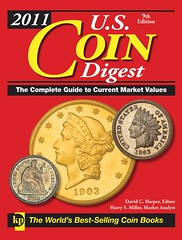 The obvious comparison for Krause's red-covered U.S. coin book is Whitman's classic "Redbook", A Guide Book of United States Coins. The books do largely cover the same territory, but I've always found that different books have different redeeming features, and I think the 2011 U.S. Coin Digest has a number of things going for it. While I'm not an active dealer or collector of U.S. coins (and thus can't vouch for the valuations), I feel I could safely recommend either publication to collectors or the general public seeking basic information and pricing information on U.S. coins.
The obvious comparison for Krause's red-covered U.S. coin book is Whitman's classic "Redbook", A Guide Book of United States Coins. The books do largely cover the same territory, but I've always found that different books have different redeeming features, and I think the 2011 U.S. Coin Digest has a number of things going for it. While I'm not an active dealer or collector of U.S. coins (and thus can't vouch for the valuations), I feel I could safely recommend either publication to collectors or the general public seeking basic information and pricing information on U.S. coins.
One similarity I commend is Krause's use of the combination hardbound/spiral format Whitman began offering a few years ago. The inner spiral binding allows pages to lay flat for easy consultation while viewing coins, and the hard outside binding fits well on any numismatist's bookshelf. It's the best of both worlds for a book meant to be consulted regularly.
While the Whitman Redbook has grown and grown over the years to include more and more useful information, the Krause Digest felt a little slim by comparison. However, this may partly be due to the book's clean layout. There is actually 55 pages of front material before the listings.
The chapters provide a well-organized overview for the novice collector or member of the general public attempting to identify and price coins. Chapter 1 is a very clean and simple Type Identification Guide with images of all major design types of regular issue U.S. coins from Half Cents to Double Eagles. For the unfamiliar it's a great way to begin the book - I can hear readers saying, "look - I've got one of those!"
Chapter 2 provides the same advice I give to everyone asking me about the value of their coins: "Don't clean your coins" and "Always hold your coin by the edge." The three-page discussion on "Care and Storage of Your Coins" is simple and to the point.
Chapter 3, "How to grade" is a nice photographic overview of circulated coin grades. A picture is worth a thousand words, and the twelve-page guide illustrates ten different common type coins (including Indian and Lincoln cents, Morgan dollars and Barber designs) in six grades from AU-55 to G-4.
Listings begin on p55 with U.S. Half Cents. This departs from the Redbook practice of listing chronologically, with colonial issues appearing first. In the Digest, colonial coinage starts on p202. I think this is a good choice for the novice reader who is far more likely to have U.S. circulation coins to look up.
Commemorative coins are listed beginning on p153, followed by bullion coins, mint and proof sets. After the colonial coin section are listings for U.S. Territorial Gold, Hawaii and the Philippines. Each section is differentiated by colored "tabs" at the outer edge of each page.
All in all, the 2011 U.S. Coin Digest is a useful book that I think will serve the novice well. My boss inherited some coins from her Mother recently, and I'll lend her my copy to see if it works in practice.
For more information, or to order, see: www.shopnumismaster.com/product/2011-us-coin-digest/
To read the earlier E-Sylum article, see: NEW BOOK: 2011 U.S. COIN DIGEST (www.coinbooks.org/esylum_v13n20a06.html)
THE BOOK BAZARRE
“New Edition of Whitman's Best-Selling Paper-Money Book”COURT TRIAL LIKELY IN CASE OF SEIZED 1933 DOUBLE EAGLES
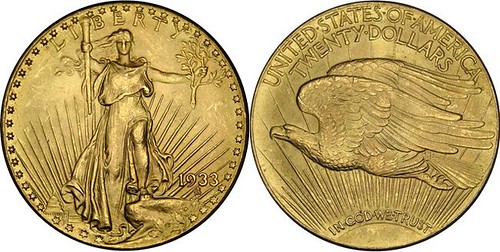
Resolution of the legal positions of the U.S. Mint and the descendants of Israel Switt over the fate of 10 genuine 1933 double eagle coins moved one step closer to trial on Oct. 28 with release of a 20-page decision by U.S. District Court Judge Legrome Davis Jr., from the federal court on the Eastern District of Pennsylvania.
A trial would occur in late 2011 or in 2012.
Both sides have been battling since September 2004 when Switt's daughter, Joan Langbord, and her two adult sons, contacted the Mint's counsel, Daniel Shaver, to ask if the Mint would authenticate 10 coins thought to be genuine 1933 double eagles. The coins were sent to Washington for review.
The family acted through New York lawyer Barry Berke, who had previously negotiated with the Mint to legalize the King Farouk-Jay Parrino-Stephen Fenton specimen that sold for $7.59 million in 2002.
Israel Switt, a Philadelphia jeweler and pawn merchant, has been identified in recent years as included in the pedigree of every known specimen of the 1933 double eagle or $20 gold piece that ever surfaced. This includes a number of pieces in the 1940s and 1950s in a series of seizures or prosecutions, usually by the United States attorney in the district where the coin was seized.
The Mint declined to return the 10 gold coins, saying in essence, “sue us,” and Berke rose to the challenge, demand the coins return in court.
Berke's pleadings laid out the case as to why Langbord and her family believed that they had the right to retain the coins and that the Mint had to seek their forfeiture, not simply retain them like a neighborhood bully. The Mint had an entirely different perspective and attempted to retain the coins as the fruit of a crime, much as a bank robber is denied the loot.
The plaintiffs basically claim the government has my coins, it took them, and we want them back. Significantly, the government now bears the burden of proof that it is the rightful owner. The problem: all through the years, the government found that when the other side had the burden, it could not be met. The shoe is on the other foot.
In the end, the Judge gave both sides a little – and Langbord's a solid procedural victory. “The Court appreciates the uniqueness of this case. But the unfamiliar landscape does not persuade it to abandon well-established legal principles, as the parties' briefs often suggest it should.”
Based on other cases and past practices called precedent, “the Court 1) denies the Government's motion for leave to file Counts II and IV of its proposed complaint; 2) grants the Government's motion for leave to file Count III of its proposed complaint; and 3) grants Plaintiffs' motion to dismiss the Government's claim of interest in the forfeiture proceeding.”
To read the complete article, see: Trial Likely for Langbord 1933s (www.numismaster.com/ta/numis/Article.jsp?ad=article&ArticleId=15442)
THE BOOK BAZARRE
AUCTION SALE 119 CLOSES ON NOVEMBER 18, 2010Featuring a Diverse Selection of Interesting and Elusive Works on Ancient, Medieval and Modern Numismatics • Particularly Rich in Numismata Americana
141 W JOHNSTOWN ROAD, GAHANNA OH 43230-2700
(614) 414-0855 • df@numislit.com • GFK@numislit.com
A PRIMER ON PLATING FOR ALL COLLECTORS
Paul G. Lajoie is cataloging his extensive collection of Statue of Liberty medals in preparation of publishing a catalog of these American idol collectibles. This week he encountered a Dieges & Clust medal that was marked: "xx gold." What was the meaning, he asked, of "xx gold?"
That is an invitation for me to talk about one of the core concepts of numismatics that is so unknown to coin collectors but is such vital information for medal collectors -- electroplating. Read carefully below; there is a quiz at the end of this discussion. To answer Paul's question first, here is what I sent him:
"xx gold" means gold plated in twice normal thickness. In effect the object is left in the plating tank a bit longer than for normal plating. The actual thickness is not that different -- it acquires the gold color early in plating. Perhaps more important is the composition of the base metal. It could be anything, but probably bronze. Brass is often used because it has a similar yellow color of gold. If the gold plating "bleeds" on such a medal showing the base metal, if brass it is not obvious.
Sounds like you are hard at work on your Statue of Liberty book. That's G R E A T!
Plating is the process of electroplating, the electrochemical process of depositing ions of a metal onto a base object. In the numismatic field it means a very thin layer of one metal is deposited on another metal already shaped by die striking or casting. This is done to improve the surface metal, its color or finish.
Electroplating is accomplished by electrolysis in plating tanks. The process uses electricity of low voltage direct current in a tank filled with a liquid electrolyte. Two electrodes are required, one of which is the item to be electroplated; it is the cathode. The other, the anode, is the source of metal to be deposited. It wears away like a bar of soap; it is sacrificial, as metal ions from the anode passes through the electrolyte, they are deposited on the cathode. Once the current is turned on, ions leave the anode, enter the electrolyte, and similar ions adhere to the cathode. The longer the item remains in the tank and the current kept on, the thicker will be the deposited layer of metal.
Generally, a precious metal is deposited on a less expensive metal, but virtually any metal can be deposited on any other metal. It might require an intermediate step, however. Gold, for example, does not bond to iron or aluminum. But it can be bonded to another metal first, say copper or nickel, then that item can be plated with gold.
Copper and copper alloys (such as bronze) are relateively inexpensive metals, and they actively bond with silver or gold, so they are widely used for shaping any item to be plated with a precious metal. You might be surprised to learn all those silver-plated tableware you have been using for years are actually struck in copper, then heavily plated with silver. These have been made in America since 1847. Thank you, Rogers Brothers.
The use of electroplating in the medallic field has a very wide use; medals are frequently plated. The most obvious reason is to create a rank of award. We all know the rank of medals range from bronze, the lowest, to silver, to gold the highest. But another surprise! All those Olympic Gold Medals are not pure gold. Even the most prestigious award medals in the Olympic Games, Olympic Gold, are actually struck in bronze and goldplated!
A typical medal to be plated is fully struck up, trimmed, and cleaned. It must be chemically clean, no grease or oil must be on its surface. (There are degreasing applications and chemicals on the market.) The medal must be free of surface debris and contaminates. Chemical cleaning creates an activated surface, one that is highly receptive to tarnish, thus the item to be plated must be inserted in the electroplating tanks as quickly as possible before this tarnish begins to form.
Medals are generally plated in a batch. So a number of medals are placed on a metal rack that is lowered into the electrolyte solution.
Usually the metal being plated can be observed in twenty minutes or so. A normal coating of a thousandth of an inch might take four hours. An extra heavy coating might require eight hours or more. (In the 19th century some items were marked -- like Paul's Dieges & Clust medal -- identifying the thickness of this plating: "xx gold" meant more than normal, "xxx gold" meant thickest plating of all.)
The electroplated metal is a thin coating. It will have the same properties on the surface as a solid medal of this metal. However, since it is a thin coating it can be worn off easily. Plated medals can be given a patina or relieved finish but care must be taken not to remove any of the thin coating. Plated medals, like all fine art medals, are almost always protected with a lacquer coating as a final step.
Plated medals wear at the high points first just like solid metal medals. Often a nose on a portrait as a high point will be first to display the under composition of the plated medal. When this occurs, it is called bleeding -- the under composition, the base metal, is exposed.
Since a silverplated item looks exactly like a solid silver item, the practice of hallmarking was created for anyone to distinguish between the two. This was necessary to indicate fineness. Plated items are not required to be so marked. Thus silver and other precious items made in the 20th century and later are required by law to indicate their fineness. This was first enacted in England in 1904. Tiffany & Co observed this and pressed for a similar law in the U.S.A., enacted 1906; thus American metalworkers call it the "Tiffany Law."
Electroplating requires an experienced operator. He must control a half dozen or more variables in the process all at once. These include such factors as voltage and current density, metal composition and cleanliness of the base surface metal, composition and purity of the anode, composition of the electrolyte solution, its pH, temperature, agitation, and other chemical factors, plus other factors. Impurities in any of these affects a desired deposition. They create electroplating anomalies (a rare form of "mint errors.")
There are so many other components of electroplating that apply to numismatic items. Perhaps they should be discussed at a later time. These include partial plating -- how to plate only a portion of a medallic surface; reverse plating -- salvaging the gold from a goldplated item; bright plating -- a surface with high reflectiveness; flash plating -- super thin coating; Sheffield plate -- plating before striking; anodizing for aluminum; and test cut -- how to determine the under composition of a plated item.
The word "plate" is also used in additional ways in the numismatic and medallic field: (1) the one side of a box medal; (2) the planchet for a side-by-side die at the Paris Mint for striking their Restrike Series; (3) large plates (like dinner plates that have been embellished with medallic items), and (4) a coin or medal illustrated on a plate in a printed catalog or book.
NOW FOR THE QUIZ: The Philadelphia Mint had electrolytic tanks from 1855 until recently. Yet, they never plated a coin or medal (to my knowledge, at least). What then, did they use these tanks for? Answer next week.
KILKENOMICS FESTIVAL CURRENCY: THE MARBLE
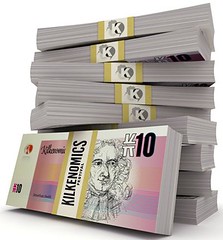 Kilkenomics is an Economics festival which will run in Kilkenny city from November 11th - 14th 2010.
Kilkenomics is an Economics festival which will run in Kilkenny city from November 11th - 14th 2010.
Twenty-four events, five venues, views from four continents, thousands of questions, hundreds of answers, one weekend
If you're like us you're finding all economics complicated and frightening in equal measure right now. What if we were to put some world class economic thinkers together with some of the best comic analytical minds available and see if they can't make all this easier to understand in a way that is entertaining, informative and funny?
With all this talk of money, we've decided to introduce our own currency – after all, Ireland's had 4 currencies in the last 40 years, so why not one more? Introducing…'The Marble'. It will have this magical quality to get more value, access special offers and buy more stuff in Kilkenny throughout the festival weekend (in pubs, restaurants, gigs, bookshops etc). For one weekend only The Marble will be strongest currency in Europe.
To read the complete article, see: Kilkenomics Festival (kilkenomics.com)
MORE ON THE GERMANY REPARATIONS COMMISSION PHOTO
Last week an E-Sylum reader asked for help identifying people pictured in a Library of Congress photo of "Reparations Commission with Stevenson, 6/25/29"
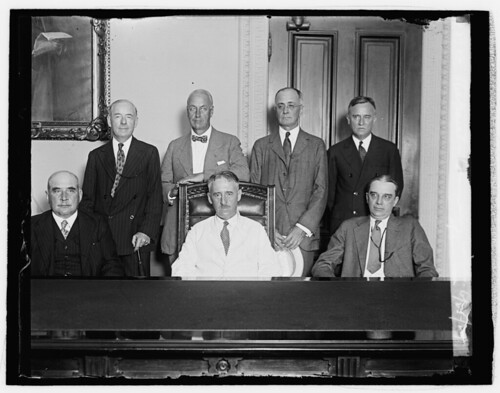
Tom DeLorey writes:
Apropos the picture of the 1929 Reparations Commission, the book "Lords of Finance" by Liaquat Ahamed identifies the U.S. delegates to the February, 1929 Reparations Conference in Paris as Owen Young and Jack Morgan, with Thomas Lamont as Morgan's alternate. Jack Morgan was the son of J.P. Morgan, and at the time the senior partner of J.P. Morgan and Associates. Lamont was the next senior partner. Young had been a delegate to the earlier (1923) Dawes Conference, and was an industrialist who was, at various times, President of GE and RCA.
The 1926 Conference convened in February, but was quite contentious and its results were not signed until July. The June photo was presumably taken when the delegation returned to Washington to report on the results.
There were several reparations conferences over the years. The 1929 conference is referred to as either the "Young Conference" or the "Second Dawes Conference." I would assume that the picture was taken after the delegation returned from the conference with their report. I do not know who they were reporting to, as the Stevenson who was Vice President did so from 1893 to 1897. The Stevenson who ran for President in the 1950's did not begin his government career until the FDR administration.
Perhaps this will help your reader with his research. The book does give an excellent history of the German hyperinflation period, but that occurred years before this picture was apparently taken.
Gar Travis writes:
I would surmise that the image was taken in 1929 as the man seated to the right is American financier Owen D. Young of the Young Plan. In 1925 he was president of the St. Lawrence University and was featured on the cover of TIME magazine. It was this image I compared to the image in eSylum to confirm his identity. www.coverbrowser.com/image/time/104-1.jpg .
For more Young Plan information, see: www.u-s-history.com/pages/h1372.html .
Pete Smith writes:
2. Bottom Row Left: John Pierpont "Jack" Morgan Jr.
3. Bottom Row Center: Secretary of State Henry Stimson
4. Bottom Row Right: Owen D. Young
With Stimson front and center, I would call this a meeting with Stimson, not Stevenson. Since I now believe the picture features Henry Stimson, I wondered if the name was transcribed incorrectly. I found the picture on the Library of Congress site. It does indeed say Stevenson.
I found another photo from the Library of Congress of Stimson taken on March 28, 1929, and I am attaching a document with the two pictures cropped and shown side by side.

A New York Times article of June 26, 1929 identifies two more individuals who may have been in the picture. These include undersecretary Joseph P. Cotton (possibly top, second from left) and undersecretary Ogden L. Mills (possibly top, far right).
I have not yet been able to find a photo of Boston lawyer Thomas Nelson Perkins. He should be in the picture and only the man at the top, second from right, remains unidentified.
So far I have been making guesses. I have tried to find an original publication with the photo identifying the subjects but so far that has eluded me. My guesses should not be assumed to be correct.
But note that this was not a photo of the Reparations Commission. It was the American delegation to the Allied Reparations Commission. I did not find a listing for the entire commission.
To read the earlier E-Sylum article, see: QUERY: GERMANY REPARATIONS COMMISSION PHOTO (www.coinbooks.org/esylum_v13n45a13.html)
MORE ON THE NORTH CAROLINA COLONIAL CURRENCY HOARD
Since we are treating the hoard as a single object, we aren't photographing the notes individually – but they are fairly representative of the 1748-1771 notes, and by in large, are heavily circulated, with the exception of the 1771 issue.
Sorry, no plans for a catalogue for the new coin exhibit.
Mark Borckardt writes:
I read about the Cornell Currency Hoard in the last issue of The E-Sylum with a personal interest. Samuel Cornell's activities in relation to the Battle of Alamance were discussed briefly. The Battle was described as “a small taxation rebellion.” However, it was much more than that.
Governor Tryon had been unfairly taxing the western North Carolina colonists for years, with no representation. That followed similar policies in western New Jersey long before. Many of the colonists had relocated to North Carolina from Western New Jersey in the early 1700s, and formed a community known as Jersey Settlement. Tryon enforced his taxation policy through unscrupulous sheriffs who yielded a heavy hand, and the local colonists formed a group known as the Regulators.
Following the Battle of Alamance, Tryon had six individuals hung for treason against the British crown. Among the six was Captain Benjamin Merrill, who was my sixth great grandfather.
To read the earlier E-Sylum article, see: COLONIAL WILLIAMSBURG ACQUIRES NORTH CAROLINA COLONIAL CURRENCY HOARD (www.coinbooks.org/esylum_v13n45a07.html)
THE BOOK BAZARRE
OFFICIAL REPLACEMENT VICTORIA CROSS MEDALS
In response to your query regarding "replacement" VCs, the short answer is yes, there are such things as "official" replacements.
I have long been interested in VCs because of my service in the Canadian Armed Forces where I came into direct contact with several living VC honorees. I undertook to confirm the location of Canadian VCs some years ago and have attached for your information (as far I know) a complete record of where VCs are that were awarded to "Canadian" recipients. Note that the definition of "Canadian" varies between authors and my list includes all of the "Canadian" honorees noted in any published list - although they may be excluded by certain authors.
You will note in the list that there are at least two replacement medals that have been displayed in Canadian museums when the original medals were stolen.
As far as I can tell, the replacement medals are made from the identical materials as the originals (i.e. an alloy containing some of the metal from captured cannons from the Crimean War. I direct you to a website link below for more information on the manufacturers of the medal (Hancocks & Co. Jewellers in London, England).
www.hancocks-london.com/vc_manufacture.htm
Most people do not realize that the medals are actually cast and not struck from dies.
Although, I don't know the specifics, I have been told that the replacement medals are marked as such in some manner to distinguish them from the original (just in case lost or stolen original medals are recovered or found).
To read the earlier E-Sylum article, see: QUERY: REPLACEMENT VICTORIA CROSS MEDALS (www.coinbooks.org/esylum_v13n45a18.html)
MORE ON COIN REPLICAS AND THE HOBBY PROTECTION ACT
 Speaking of replicas: Regarding the tiny "COPY" inscription on the Higley copper reproduction illustrated in previous issues, I wrote: "I thought that "COPY" was a wee bit small myself. So which regulatory agency is in charge of enforcing the Hobby Protection Act?"
Speaking of replicas: Regarding the tiny "COPY" inscription on the Higley copper reproduction illustrated in previous issues, I wrote: "I thought that "COPY" was a wee bit small myself. So which regulatory agency is in charge of enforcing the Hobby Protection Act?"
Ben Keele writes:
The Federal Trade Commission issues the regulations, and they are found at Title 16, Part 304 of the Code of Federal Regulations. This link will take you straight to an official copy on the Government Printing Office's website:
www.gpo.gov/fdsys/pkg/CFR-2010-title16-vol1/
pdf/CFR-2010-title16-vol1-part304.pdf.
David Ganz writes:
FTC (Federal trade commission), but it is also a private action statute (that is an individual citizen can bring the claim and obtain damages and reasonable attorneys fees.
On a related note Philip Mernick writes:
I was reading the items about Peter Rosa reproductions. Not, as far as I know, having seen one, I have to ask how easy they are to distinguish from the originals. They are made from pewter but plated and toned to match the original and not (I presume) marked "replica". They could fool somebody bidding on-line but would they fool a collector at a coin show?
Our coins are made of the finest lead and cadmium-free pewter. This the same type of pewter that is used for dinner plates and drinking cups.
The coins are electroplated with a pure silver, 24 karat gold or copper, depending on the original coins' metallic make up.
The silver and copper coins are then patinated and finished by hand to give them an aged looked.
To read the CoinReplicas FAQ page, see: FAQs (www.coinreplicas.com/about/faqs)
To read the earlier E-Sylum article, see: COIN REPLICAS AND THE HOBBY PROTECTION ACT (www.coinbooks.org/esylum_v13n45a08.html)
MORE ON THE LOUIS ELIASBERG COLLECTION
Mark Borckardt writes:
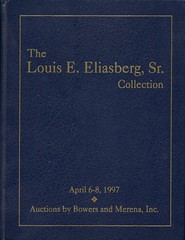 A further point of clarification can be made: Louis E. Eliasberg, Sr. passed away in 1976. Even though the gold collection was not sold until 1982, and the silver and copper portion in 1996 and 1997, the collection was complete for all date and mintmark varieties of U.S. coins known to exist at the time of his death. Post-1976 coins were not included, and issues unknown at the time of his death were not included. In the latter category is the 1870-S half dime, that was unknown at the time of his death but well known 20 years later when his half dimes were sold.
A further point of clarification can be made: Louis E. Eliasberg, Sr. passed away in 1976. Even though the gold collection was not sold until 1982, and the silver and copper portion in 1996 and 1997, the collection was complete for all date and mintmark varieties of U.S. coins known to exist at the time of his death. Post-1976 coins were not included, and issues unknown at the time of his death were not included. In the latter category is the 1870-S half dime, that was unknown at the time of his death but well known 20 years later when his half dimes were sold.
The collection also had many important varieties, along with extensive holdings of colonials, patterns, territorial gold, world coins, and currency. I have fond memories working with parts of the collection.
One of the interesting things to me was that older coins tended to be far higher quality than more modern coins. He had several Mint State Flowing Hair and Draped Bust dollars, including Gem coins, but his 1934-S Peace dollar, for example, graded just XF45. That was obviously because Mr. Eliasberg collected many of the modern coins from his own pocket change. Like most collectors of his generation, once a coin was acquired, there was no interest in upgrading.
To read the earlier E-Sylum article, see: LOUIS ELIASBERG'S 1873-CC NO ARROWS DIME LETTER OF RECEIPT (www.coinbooks.org/esylum_v13n45a11.html)
NOTES FROM E-SYLUM READERS: NOVEMBER 14, 2010
Regarding the images of three-cent Feuchtwanger tokens, Myron Xenos writes:
I see in the photographs several discrepancies which I don't think are caused by the digitalization. Tail-to-edge and other space differences seem evident to me. Of course I am older now and my eyes aren't that great. That's why I gave up on coppers. Gold and silver are easier on old eyes.

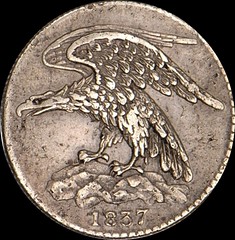
To read the earlier E-Sylum article, see: ON THE STICKNEY THREE CENT FEUCHTWANGER SPECIMEN (www.coinbooks.org/esylum_v13n45a09.html)
Joe Boling writes:
Just when some are initiating their Facebook presences (Kolbe and Fanning last week) I am closing my Facebook account. The outfit has been just too cavalier about protecting user information - it's asking for trouble, in my opinion, for someone concerned about security and privacy to use that service.
Regarding this statement in the American Antiquarian Society item on a piece of baseball-related ephemera, "Advertisers have long used the image of popular baseball players and baseball teams to hock their wares. ", Joe adds:
hock [?!?] Putting them into pawn? I had to look carefully to make sure this was not your choice of language.
To read the earlier E-Sylum item, see: W.S. HILL BASEBALL ADVERTISING NOTE (www.coinbooks.org/esylum_v13n45a16.html)
I have been reading through my back issues hence this slightly late reply. You mention the John Lennon "coin" and the impression may have been given that it is a UK coin. It will, in fact, be made by the Royal Mint for the small island of Alderney, off the coast of France.
To read the earlier E-Sylum article, see:
ROYAL MINT STRIKES JOHN LENNON COIN
(www.coinbooks.org/esylum_v13n44a20.html)
WAYNE'S NUMISMATIC DIARY: NOVEMBER 14, 2010
Tuesday the 9th was the night of the November meeting of Nummis Nova, my Northern Virginia numismatic social group. Our host was Gene Brandenberg, who made reservations for us at the Union Street Public House in Old Town Alexandria, VA. For many years Gene operated a coin shop right next door. The location was especially convenient for Bill Eckberg, who lives within walking distance.
I had a longer haul to get there, but after locating a parking space I arrived at the restaurant about 6:35pm. Several folks were already there, seated at a table in the upstairs dining room. I took an empty chair across from Tom Kays and next to my guest for the evening, Edmund Moy, Director of the U.S. Mint.
Ed had been invited earlier by Roger Burdette, who knew him through his work on the Citizen's Coinage Advisory Committee (CCAC). But because of his travel schedule, it had been difficult to find an open date. I followed up with Ed via email, and we picked November a couple months ago. Luckily, he remained open and was able to attend.
It was great to finally meet him - I don't get out much to Mint events or major coin shows. He's been a very active Mint Director, and travels the country introducing new coin designs at their launch events. He clearly enjoys his work. He recounted for some of us how he came to get the appointment and receive the word by phone from President Bush.
He acknowledged that the tough part of the job is dealing with multiple constituencies. With so many interested parties, it's inevitable that some will be unhappy. There's the blue-collar factory workforce, Treasury officials, suppliers and contractors, coin collectors and the general public, among others. He seemed happy to be among a group that didn't have a complaint or want something from him. As always, our group was there for the fun part of numismatics - sharing stories, coins, and fellowship.
Absent were regulars Roger Burdette and Wayne Herndon, whose work schedules got in the way. Those present included Chris Neuzil, Jon Radel, Joe Levine, Dave Shenkman and Julian Leidman.
Julie went up to introduce himself to Ed Moy, and ended up taking my seat for a long conversation. But I like to mingle, and stayed at the other end for our meals, speaking with Joe and Dave. Dave passed around a slabbed 1798 dollar along with three different Gallery Mint dollar reproductions. One had a triple error, made to order for him by the Gallery Mint's Ron Landis.
I had a couple binders of ephemera relating to the U.S. Mint and coin legislation, including a copy of the April 12, 1792 National Gazette, featuring the full text of the 1792 Mint Act, covering all of the front page and part of page 2 (see, I'm not selling ALL of my neat newspapers)!

Also included were two scarce reports of the Director of the Mint (1867 and 1872).

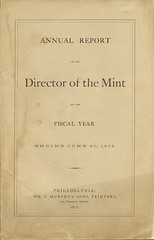
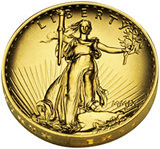 Other topics of conversation included Chief Engraver John Mercanti and the 2009 Ultra-High Relief Saint-Gaudens $20 gold coins. After waiting to allow everyone else a chance to acquire one, Director Moy bought one on the last day of sale and only after everyone was sure they weren't going to be sold out.
Other topics of conversation included Chief Engraver John Mercanti and the 2009 Ultra-High Relief Saint-Gaudens $20 gold coins. After waiting to allow everyone else a chance to acquire one, Director Moy bought one on the last day of sale and only after everyone was sure they weren't going to be sold out.
Tom expressed interest in a rare undated handwritten manuscript among the ephemera I'd brought. The six-page article written by "A.M. Smith, Numismatist, Philadelphia" is titled "Rare U.S. Coins". I purchased it in the January 2002 Stack's Americana Sale (lot 522). Here's a link to a slideshow on Flickr: A.M. Smith Manuscript, "Rare U.S. Coins" (www.flickr.com/photos/coinbooks/sets/72157625259908701/show/).


Tom and I spent part of the evening discussing the events for kids that Jon Radel and I help run at Wayne Herndon's Northern Virginia coin shows. While at the recent Virginia Numismatic Association show in Richmond, Tom solicited donations of numismatic items to be given to the kids or sold at the kids' auction. He'd brought with him a canvas Mint bag holding about 40 pounds of coins! On top of that, he had another bag of coins, some of which he'd placed in specially made holders. Wow!
As the dinner broke up we all thanked Ed for coming and invited him to come again. He gave everyone his business card. It had been a very enjoyable evening. Tom offered to walk me to my car to help haul the donated coins. I dropped him off at his car on the way out of Alexandria.
The rest of the week flew by quickly, and I did little numismatically, not even working much on The E-Sylum. But I did send out some emails to start the planning process for the next kids' event, to be held December 11th at the Annandale, VA coin show. I made arrangements to meet Wayne Herndon at his office Saturday morning to organize the giveaways and auction lots.
It was an unusual weekend for me - my wife had taken the family up to Pittsburgh to celebrate her niece's birthday and attend a wedding shower. I stayed home tending to chores and Max the Dog. I got up early Saturday, walked Max, went for a run, and installed some weather-stripping around our doors (winter's coming)! After 11am I left the house.
Wayne's office is spacious, yet crowded with work areas and merchandise. In back is a small warehouse for all of his Wizard Coin Supply stock and displays. I took pictures of the coin book aisle. Before I left his wife Karin and son Kyle arrived, on hand to help unload a shipment arriving later by truck.
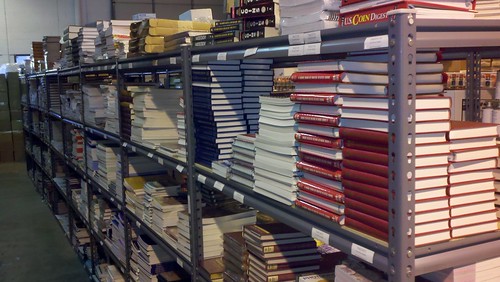
We talked about plans for the next Nummis Nova dinner. On the way home I grabbed lunch at Buffalo Wild Wings, taking advantage of the free Wi-Fi to work on a few articles for this E-Sylum. But Max was waiting, so I didn't dawdle.
Back home, after walking Max I scanned images for this article. I worked on the issue off and on over the rest of the weekend between other chores. The gang arrived back home about 8:30pm Sunday. It's a school night, so it was time for the kids to shower and get to bed. I was able to publish The E-Sylum a little early and watch the Steeler football game. The weekend was a nice break, but it's back to the old grind tomorrow. Keep those E-Sylum emails coming, folks.

Another of Tuesday night's exhibits
THE BOOK BAZARRE
SO WHAT'S A 'DEL BOY'?
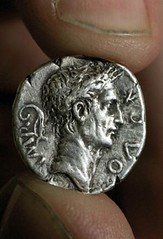 Regarding this passage in a U.K. newspaper article, I asked "So what's a "Del Boy"? How are early counterfeits like these catalogued in the literature?"
Regarding this passage in a U.K. newspaper article, I asked "So what's a "Del Boy"? How are early counterfeits like these catalogued in the literature?"
A Roman coin discovered by a Brighton cleaner was struck at the time of Christ by a "Del Boy" forger who could not spell and did not know one emperor from another...
Jim Duncan of New Zealand writes:
Del boy was a TV character played by English actor David Jason in a series called "Only Fools and Horses" which revolved around a family of 'wide boys' of which Del was the leader, plus his Grandad and younger brother Rodney. They specialised in unlikely scams on gullible punters - like selling them London Bridge and the toll rights (as you know there ARE no tolls).
His tall skinny brother was Rodney played by Nicholas Lyndhurst, "Oh Rodders, you plonker". The surname was Trotter, and Del Trotter careened around the high-rise apartment buildings (or 'estates') of London in a 3-wheeled Robin Reliant (or similar).
A wide boy is a 'late' teddy boy - loud clothing, small brain, endless optimism. The show was very popular in 'english' speaking countries! A plonker is an idiot, and Rodney was always putting his foot in it.
Philip Mernick forwarded a link to a page on WikiPedia: en.wikipedia.org/wiki/Del_Boy .
Del is a lively character, most noted for his happy-go-lucky, confident persona. Whilst not always being successful, his general confidence and often forcefulness often convinces people to believe in him.
With a never-ending supply of get-rich-quick schemes and an inner belief in his ability to sell anything to anyone, Del embroils 'the firm' (as he calls the family business) in all sorts of improbable situations. It is this unwavering confidence that led to his oft-proclaimed but rarely realised ambition "This time next year, we'll be millionaires!"
To read the earlier E-Sylum article, see: METAL DETECTORIST FINDS UNUSUAL COUNTERFEIT ROMAN COIN (www.coinbooks.org/esylum_v13n45a19.html)
DECEMBER 2010 SPINK SALE OF ANCIENT, ENGLISH AND FOREIGN COINS

924 James I, second coinage 1604-19, Rose Ryal, 13.76g, m.m. trefoil over castle both sides, king crowned seated on throne, portcullis below, rev. shield on rose (cf. Schneider II, 10; N.2079; S.2613), obverse struck from rusty dies, good very fine, rare
To view the complete catalogue, see: Ancient, English & Foreign Coins & Commemorative Medals (2nd Dec 2010) (www.spink.com/auctions/pdf/1012.pdf)
IRELAND'S “BARNYARD” EURO COIN SERIES EXTENDS CLASSIC DESIGNS
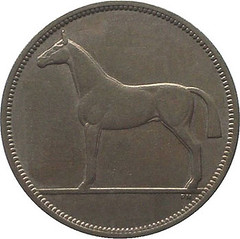 The Central Bank and Financial Services Authority of Ireland will issue a very special silver coin honoring their well known and much loved “Barnyard” series of circulating coins designed by Percy Metcalfe and first issued in 1928. This will be the first time Percy Metcalfe's artwork will be presented in the Euro currency.
The Central Bank and Financial Services Authority of Ireland will issue a very special silver coin honoring their well known and much loved “Barnyard” series of circulating coins designed by Percy Metcalfe and first issued in 1928. This will be the first time Percy Metcalfe's artwork will be presented in the Euro currency.
As a tribute to the first coins of the Irish state, the Central Bank has chosen to expand these designs and give them more relevancy within the EURO by updating them within a “New Generation.”
Percy Metcalfe's original designs are replicated and have been re-tooled and sharpened slightly for more vivid detail. The difference is with the addition of the animal's offspring. The original coins show the animals in profile with quite basic anatomical depictions. This is still the case with the “Horse” coin for example, but now, we will see a foal casually looking towards us in a more relaxed pose.
The first coin in the series will see the issue of the redesign of the Horse, with the Salmon and smolt in 2011 and the Irish Wolfhound with pup following in 2012.

To read the complete article, see:
Central Bank of Ireland to Issue “Barnyard” Euro Coin Series
(news.coinupdate.com/central-bank-of-ireland
-to-issue-barnyard-euro-coin-series-0426/)
TRUE STORY: THE UPSIDE DOWN COIN INSCRIPTION
Caller: I have a silver dollar (voice inflection confirms accuracy of caller id location: Birmingham, AL)
Dealer: OK
Caller: It's a 2008.
Dealer: mm hmm
The letters on the side are upside down. I was wonderin' if that was unusual…
Dealer: (pause) I doubt that they are. You probably just need to turn the coin over.
Caller: (long pause. The thought process and moving of the coin are palpable across the phone line)… All right then. Preciate it.
Dealer: You bet.
Dennis Tucker of Whitman Publishing adds:
And that's probably one of the easier phone calls! No arguments; no angry demands that you buy the coin for a million dollars; no awkwardly fabricated story about how the 2008 “silver dollar” was inherited in Grandpa's estate. . . .
We get doozies from time to time here at Whitman. The sad ones are the long, laboriously handwritten letters where you can tell the person really doesn't have all their faculties anymore, and they're probably in danger of being defrauded if they take their coins to a pawn shop or something.
But some are just flat-out crazy.
“What's wrong with R.S. Yeoman? He gives totally different prices in the Red Book and the Blue Book, from the same year! I dare Mr. Yeoman to write back and explain!”
FEATURED WEB SITE: MILITARY COIN COLLECTING
This week's Featured Web Site is suggested by John and Nancy Wilson, who write:
Here is a site that gives information on challenge coins. Lots of people along with our military carry challenge coins. The MPC Fest in Ohio is always well attended and probably raises enough money for several scholarships to the ANA Summer Seminar. Fests are held annually at many coin shows. Challenge coins are a great collecting area and were sure that some E-Sylum readers aren't aware of them as a collectible.

www.2-clicks-coins.com/article/
military-coin-collecting.html

